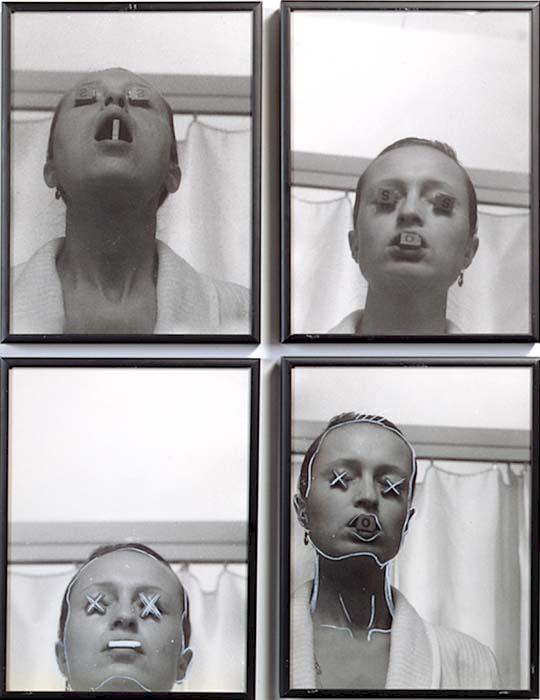1964 - 1989
09.05.07 bis 23.06.07
Opening on May 9, 2007, Zwirner & Wirth will present an exhibition of American and European conceptual photography drawn from a private collection. Spanning the years 1964-1989, the collection, which has been amassed over the last three decades, includes key examples of photo-based conceptual art by artists such as Vito Acconci, Giovanni Anselmo, John Baldessari, Bernd & Hilla Becher, Mel Bochner, Hans Breder, Marcel Broodthaers, Peter Campus, Robert Cumming, Valie Export, Fischli & Weiss, Dan Graham, Birgit Jürgenssen, Barry Le Va, Sol LeWitt, Robert Mapplethorpe, Ana Mendieta, Bruce Nauman, Meret Oppenheim, Hélio Oiticica, Giulio Paolini, Giuseppe Penone, Sigmar Polke, Richard Prince, Charles Ray, Allen Ruppersberg, Lucas Samaras, Laurie Simmons, Andy Warhol, and others. An open-ended term, “conceptual art” encompasses a broad range of practices that emphasize the role of ideas in the production of artistic meaning. Beginning roughly in the 1960s and 70s, artists would question the traditional visual or aesthetic definition of the work of art in favor of more idea-driven, critical work. Photography would become central in the development of conceptual practices, as it proved to be a medium that could be implemented by artists in various ways, and the exhibition at Zwirner & Wirth will reflect a broad range of influential, conceptual photo-based work. Photography would prove, for example, to be a useful tool in the recording of site-specific or performance events. The exhibition will present a selection of photographs that document performances by artists including the Viennese Actionist Rudolf Schwarzkogler (in an Untitled Action from 1965), Charlotte Moorman (performing a piece conceived with Nam June Paik, titled "New Sounds From Old Rubbish and Bare Bodies" in London in 1969), and Joan Jonas (performing Twilight, 1975), among others who expanded the field of art towards unconventional or time-based genres. Other artists would create explicitly photo-based works—often made up of several images or juxtaposed with text—that relate to performative, or process-oriented experiments. Among them, Vito Acconci is featured in the exhibition with works including Contacts, 1971, which relates to a performance of the same name. This work is made up of four gelatin-silver prints that show the artist standing blindfolded with a woman kneeling before him who holds her hand over parts of his body as he attempts to sense the location of her hand solely from body heat. Here, Acconci explores perception and communication by simultaneously investigating physical and mental processes.
Several other artists in the exhibition document their own bodies as sites of critical investigation. Among them, Bruce Nauman, whose 5-part work Studies for Holograms (a–e), 1970 comprises a series of five images of the artist contorting, pinching, and pulling on his own face and Charles Ray, whose Plank Piece I, II , 1973 shows GIUSEPPE PENONE Rovesciare i propri occhi (To Reverse One's Eyes) 1970 two images of the artist hanging from a diagonally-positioned plank, explore how the body can be manipulated as a sculptural material. Hans Brederʼs Body Sculptures, 1971-72 similarly blur the boundaries between photography, sculpture, and performance, documenting complex compositions made of bodies and mirrors. Other works by artists such as Giovanni Anselmo (whose Entering the Work, 1971 shows the artist running through the visual frame of the photograph), Giuseppe Penone (who created a series of images in the 1970s of his own arms and hands juxtaposed with their physical, indexical imprints), and John Baldessari (who makes himself the subject of a photographic commentary on his situation as an artist in Born to Paint, 1968), offer a range of conceptual examples of photographic self-portraiture. Furthermore, conceptual photography displays a critical engagement with the conditions of the medium of photography itself. Photographyʼs inherent seriality and reproducibility is investigated in works by artists such as Dan Graham, who displays photographic images of tract housing and other repetitive architectural structures in the images from his seminal Homes for America, 1966-67 series, among others. Moreover, several artists in the exhibition question photographyʼs supposed neutrality and objectivity by exploring the construction of photographic meaning in visual presentations of staged scenarios. For example, Allen Ruppersbergʼs 100 Miles per Hour, 1972 shows a sequence of images that show the artist enacting an automobile crash with toy cars and his own body, and the Swiss artists Fischli & Weiss humorously reconstruct scenes such as a fashion show or customers browsing in a carpet shop using sausages and cold-cuts as props in their Sausage Series, 1979.
